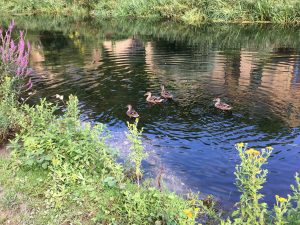I spent a quiet morning as I waited for the skies to clear, ran a few errands — had to buy some Wellington boots for my remaining time in the English countryside. While walking through town I discovered the Oldest Bar in Englands — The Royal Oak and the City Cross, from the 14th C. Locally known as the Butter Cross, the structure was a focal point for civic ceremonies in the later Middle Ages. There are now twelve figures on the monument. Each face of the monument has a large figure about half way up, surmounted by two smaller figures in niches. The eight figures at high level represent, The Blessed Virgin, and the Saints Bartholomew, John, Lawrence, Maurice, Peter, Swithun, and Thomas. After lunch and a midday rain the skies cleared and I took myself for a long walk.
I set off on the South Downs Way is a long distance footpath and bridleway and is one of 15 National Trails of England and Wales. It runs about 100 miles along the South Downs in Southern England. I followed it for awhile, and then saw signs for the Itchen Way, a 30-mile walk, following the River Itchen from its source to its confluence with Southampton Water. On the way it passes some beautiful stretches of chalk river, and also follows much of the Itchen Navigation. It passes through the centre of historic Winchester on the way, passing close to the Cathedral. So I took that turn and was soon walking along the River on some sorta muddy trails.
In pre-histortic times the Itchen flowed in two main channels in the center of the river valley, and was nearly twice as wide as it is today. There were some old locks, bridges and water meadows from the 18th C from when the Itchen Navigation was used for transporting barges of coal and timber from Southhampton to Winchester. I watched for water voles and had really hoped to see an otter, but only found swans and a few ducks along the way.
At the midpoint of my walk I found St. Catherine’s Hill, which is known these days for it’s lovely viewpoints, but was in earlier times there was a Norman chapel which is buried under the ‘Clump’ of trees at the top. I didn’t see any ruins of the chapel of any other dwellings — it’s simply a beautiful spot to see the lovely Hampshire countryside, and distant view of the Cathedral. The steps and slopes were slippery, so I was glad to be on a level path as I headed back to town along the River.
The City Mill has existed on a site at the edge of the city, and on the River since at least Saxon times; the foundation of the building suggests that the Saxon mill was possibly established on the site of an earlier Roman mill. Early records from 932AD and 989AD refer to a watermill, owned by the Benedictine nunnery of Wherwell. In 2004, a 12-year restoration program came to a successful conclusion, and after a hiatus of at least 90 years the mill again milled flour by water power. The water wheel can be seen working daily throughout the year and flour milling is demonstrated every weekend of the year.
And that was Thursday.
















My kinda town.